Soba Noodles Roast Beef Food Network
 Shōyu ramen | |
| Alternative names | shina soba, chūka soba |
|---|---|
| Type | Noodle soup |
| Place of origin | Yokohama Chinatown, Japan |
| Region or state | Eastern asia |
| Serving temperature | Hot |
| Main ingredients | Chinese-style wheat noodles, meat- or fish-based broth, vegetables or meat |
| Variations | Many variants, peculiarly regional, with various ingredients and toppings |
| |
Ramen () ( 拉麺, ラーメン , rāmen , IPA: [ɾaꜜːmeɴ]) is a Japanese noodle dish. It consists of Chinese-style wheat noodles (chūkamen) served in a meat-based broth, oftentimes flavored with soy sauce or miso, and uses toppings such every bit sliced pork ( 叉焼 , chāshū ), nori (dried seaweed), menma, and scallions. Ramen has its roots in Chinese noodle dishes:[1] virtually every region in Japan has its own variation of ramen, such equally the tonkotsu (pork bone goop) ramen of Kyushu, and the miso ramen of Hokkaido. Mazemen is a ramen dish that is not served in a soup, merely rather with a sauce (such as tare).
History [edit]
Etymology [edit]
The word ramen is a Japanese borrowing of the Standard mandarin Chinese lāmiàn ( 拉麵 , "pulled noodles").[2] [3] In 1910, the offset ramen shop named Rairaiken (来々軒) opened in Asakusa, Tokyo, where the Japanese owner employed 12 Cantonese cooks from Yokohama's Chinatown and served the ramen arranged for Japanese customers.[iv] [5] Until the 1950s, ramen was called Shina soba (支那そば, literally "Chinese soba"). Today Chūka soba (中華そば, also significant "Chinese soba") or just ramen (ラーメン) are more common, as the word "支那" (Shina, pregnant "China") has acquired a debasing connotation.[vi]
Origin [edit]
Ramen is a Japanese[7] accommodation of Chinese wheat noodles.[eight] [9] [10] [11] [12] I theory says that ramen was introduced to Japan during the 1660s past the Chinese neo-Confucian scholar Zhu Shunsui who served as an advisor to Tokugawa Mitsukuni after he became a refugee in Japan to escape Manchu rule and Mitsukuni became the first Japanese person to eat ramen. About historians reject this theory every bit a myth created past the Japanese to embellish the origins of ramen.[13]
According to historians, the more plausible theory is that ramen was introduced to Japan in the late 19th[8] [14] or early 20th century by Chinese immigrants living in the Yokohama Chinatown.[15] [16] Co-ordinate to the tape of the Yokohama Ramen Museum, ramen originated in China and made its mode to Nihon in 1859.[14] Early versions were wheat noodles in broth topped with Chinese-manner roast pork.[8]
By 1900, restaurants serving Chinese cuisine from Canton and Shanghai offered a simple dish of noodles (cut rather than hand-pulled), a few toppings, and a broth flavored with salt and pork bones. Many Chinese living in Japan also pulled portable food stalls, selling ramen and gyōza dumplings to workers. Past the mid-1900s, these stalls used a blazon of a musical horn called a charumera (チャルメラ, from the Portuguese charamela) to advertise their presence, a practice some vendors still retain via a loudspeaker and a looped recording. By the early Shōwa flow, ramen had get a popular dish when eating out.[ citation needed ] Co-ordinate to ramen expert Hiroshi Osaki, the first specialized ramen store opened in Yokohama in 1910.[11] [17]
Postwar popularization [edit]
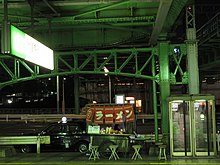
After Japan'due south defeat in World State of war II, the American military occupied the country from 1945 to 1952.[8] In December 1945, Japan recorded its worst rice harvest in 42 years,[8] [18] which caused food shortages equally Japan had drastically reduced rice product during the state of war as production shifted to colonies in China and Formosa island.[eight] The Usa flooded the market with cheap wheat flour to deal with food shortages.[eight] From 1948 to 1951, breadstuff consumption in Nihon increased from 262,121 tons to 611,784 tons,[8] just wheat also establish its mode into ramen, which about Japanese ate at black market food vendors to survive as the government food distribution system ran nigh xx days backside schedule.[8] Although the Americans maintained Japan's wartime ban on outdoor nutrient vending,[8] flour was secretly diverted from commercial mills into the black markets,[eight] where nearly 90 percentage of stalls were under the control of gangsters related to the yakuza who extorted vendors for protection money.[8] Thousands of ramen vendors were arrested during the occupation.[8]
In the same flow, millions of Japanese troops returned from China and continental E Asia from their posts in the Second Sino-Japanese War. Some of them would take been familiar with wheat noodles.[viii] By 1950 wheat flour substitution controls were removed and restrictions on food vending loosened, which further boosted the number of ramen vendors: individual companies even rented out yatai starter kits consisting of noodles, toppings, bowls, and chopsticks.[8] Ramen yatai provided a rare opportunity for small calibration postwar entrepreneurship.[8] The Americans also aggressively advertised the nutritional benefits of wheat and animal protein.[8] The combination of these factors acquired wheat noodles to gain prominence in Japan'southward rice-based culture.[8] Gradually, ramen became associated with urban life.[8]
Modernistic menstruum [edit]
A hot bowl of tonkotsu ramen in Tokyo
In 1958, instant noodles were invented by Momofuku Ando, the Taiwanese-Japanese founder and chairman of Nissin Foods. Named the greatest Japanese invention of the 20th century in a Japanese poll,[19] instant ramen allowed anyone to make an approximation of this dish simply by adding boiling water.
Beginning in the 1980s, ramen became a Japanese cultural icon and was studied around the earth. At the aforementioned fourth dimension, local varieties of ramen were hitting the national market and could even be ordered past their regional names. A ramen museum opened in Yokohama in 1994.[xx]
Today ramen is one of Japan'southward near popular foods, with Tokyo alone containing effectually five,000 ramen shops,[8] and more than than 24,000 ramen shops beyond Nihon.[21] Tsuta, a ramen eatery in Tokyo's Sugamo district, received a Michelin star in Dec 2015.[21]
Types [edit]
A wide multifariousness of ramen exists in Japan, with geographical and vendor-specific differences fifty-fifty in varieties that share the same name. Although ramen usually has toppings, ramen can be broadly categorized past its two main ingredients: noodles and broth.
Noodles [edit]
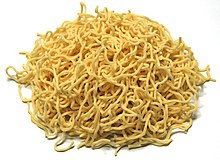
Most noodles are made from iv basic ingredients: wheat flour, salt, water, and kansui ( かん水 ) (from kansui ( 鹼水 , alkali metal water)) a type of alkaline mineral water, containing sodium carbonate and usually potassium carbonate, as well as sometimes a small-scale corporeality of phosphoric acid. Although ramen noodles and Udon noodles are both made with wheat and are like, they are dissimilar kinds of noodle.
The kansui is the distinguishing ingredient in ramen noodles, and originated in Inner Mongolia, where some lakes contain big amounts of these minerals and whose water is said to be perfect for making these noodles. Making noodles with kansui lends them a yellowish hue every bit well as a firm texture.[ citation needed ] Eggs may likewise be substituted for kansui. Some noodles are made with neither eggs nor kansui and should only be used for yakisoba, every bit they take a weaker structure and are more than decumbent to soaking up moisture and becoming extremely soft when served in soup.[ citation needed ]
Ramen comes in various shapes and lengths. It may exist thick, thin, or even ribbon-similar, every bit well every bit straight or wrinkled.
Traditionally, ramen noodles were made by paw, merely with growing popularity many ramen restaurants prefer to use noodle-making machines to meet the increased need and improve quality. Automatic ramen-making machines imitating transmission production methods take been available since the mid. 20th century produced by such Japanese manufacturers as Yamato MFG. and others.[22]
Soup [edit]

Ramen soup is more often than not made from stock based on chicken or pork, combined with a multifariousness of ingredients such as pork bones, katsuobushi (skipjack tuna flakes), niboshi (dried infant sardines),[23] beef bones, shiitake, onions, and kombu (kelp). Some modern ramen broths can likewise exist vegetable-based. Tare is often added to goop to make the soup.
- Tonkotsu (豚骨, "pork bone"; not to exist dislocated with tonkatsu) soup is broth with a typically translucent white colored appearance. Like to the Chinese baitang (白湯), it has a thick broth made from humid pork bones, fat, and collagen over high heat for many hours, which suffuses the goop with a hearty pork flavor and a flossy consistency that rivals milk, melted butter or gravy (depending on the store). Although Tonkotsu is merely a kind of broth, some people consider tonkotsu ramen (specialty of Kyushu, its birthplace) a singled-out flavour category. [24]
- Torigara (鶏がら, "Craven bone") soup based on chicken bone broth originated mainly in Tokyo. Information technology is oftentimes used as a base for common salt and shoyu ramen.[25]
Flavors [edit]
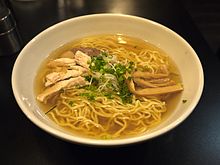


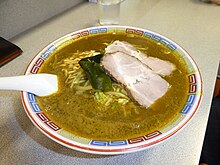
The resulting combination is by and large divided into several categories. Although newer and older variations oft make this categorization less clear-cut, a description of said quondam variations is equally follows:
- Shio (塩,"salt") ramen is the oldest of the four types.[24] It has a pale, clear, yellowish goop made with enough of common salt and any combination of chicken, vegetables, fish, and seaweed. Occasionally pork bones are also used, merely they are not boiled equally long as they are for tonkotsu ramen, so the soup remains light and articulate. Chāshū is sometimes swapped for lean chicken meatballs, and pickled plums and kamaboko (a slice of processed fish scroll sometimes served as a frilly white circle with a pink or blood-red spiral called narutomaki) are pop toppings equally well. Noodle texture and thickness varies amongst shio ramen, but they are usually straight rather than curly. "Hakodate Ramen" is a well-known version of shio ramen in Nihon.
- Shōyu (醤油, "soy sauce") ramen has a clear brown broth, based on a craven and vegetable (or sometimes fish or beef) stock with plenty of soy sauce added resulting in a soup that is tangy, salty, and savory yet yet fairly calorie-free on the palate. Shōyu ramen usually has curly noodles rather than straight ones, although this is not e'er the case. It is often adorned with marinated bamboo shoots or menma, scallions, ninjin (carrot), kamaboko (fish cakes), nori (seaweed), boiled eggs, edible bean sprouts or blackness pepper; occasionally the soup will besides comprise chili oil or Chinese spices, and some shops serve sliced beef instead of the usual chāshū.
- Miso (味噌) ramen have reached national prominence around 1965. This uniquely Japanese ramen, which was developed in Sapporo Hokkaido, features a broth that combines copious miso and is blended with oily chicken or fish broth – and sometimes with tonkotsu or lard – to create a thick, nutty, slightly sweet and very hearty soup. Miso ramen goop tends to have a robust, tangy season, and so information technology stands up to a variety of flavorful toppings: spicy bean paste or tōbanjan (豆瓣醤), butter and corn, leeks, onions, edible bean sprouts, ground pork, cabbage, sesame seeds, white pepper, and chopped garlic are common. The noodles are typically thick, curly, and slightly chewy.
- Karē (カレー,"back-scratch") ramen is a relative newcomer, cooked with curry soup. In Japan, several cities claim to be its identify of origin. The city of Muroran claims it originated there in 1965[26] (meet also Muroran back-scratch ramen), while the city of Sanjō city claims to take had kare ramen for over eighty years,[27] and the city of Katori also claims to have been the site of its origin.[28] Back-scratch soup is mainly made with pork bones and vegetables and is seasoned with curry. The noodles are thick and curly. Toppings include chāshū, wakame, and edible bean sprouts.
Toppings [edit]
Later on basic preparation, ramen can be seasoned and flavored with whatsoever number of toppings, including but not limited to:[29]
- Chāshū (sliced barbecued or braised pork)
- Negi (green onion)
- Takana-zuke (Pickled and seasoned mustard leaves)
- Seasoned (usually salted) boiled egg (Soy egg ("Ajitsuke Tamago"))
- Bean or other sprouts
- Menma (lactate-fermented bamboo shoots)
- Kakuni (braised pork cubes or squares)
- Kikurage (wood ear mushroom)
- Nori (dried seaweed)
- Kamaboko (formed fish paste, often in a pinkish and white spiral called narutomaki)
- Squid
- Umeboshi (pickled plum)
- Corn
- Butter
- Wakame (a type of seaweed)
- Olive oil
- Sesame oil
- Soy sauce
- Other types of vegetables
Preference [edit]
Seasonings commonly added to ramen are white pepper, black pepper, butter, chili pepper, sesame seeds, and crushed garlic.[30] Soup recipes and methods of grooming tend to be closely guarded secrets.
Most tonkotsu ramen restaurants offer a organisation known as kae-dama (替え玉), where customers who take finished their noodles can request a "refill" (for a few hundred yen more) to be put into their remaining soup.[31]
Regional variations [edit]
While standard versions of ramen are available throughout Japan since the Taishō menstruum, the final few decades have shown a proliferation of regional variations, unremarkably referred to as gotouchi ramen (ご当地ラーメン). Some of these which accept gone on to national prominence are:
- Sapporo, the capital of Hokkaido, is especially famous for its ramen. Virtually people in Nihon associate Sapporo with its rich miso ramen, which was invented there and which is platonic for Hokkaido'due south harsh, snowy winters. Sapporo miso ramen is typically topped with sweetcorn, butter, bean sprouts, finely chopped pork, and garlic, and sometimes local seafood such as scallop, squid, and crab. Hakodate, another city of Hokkaido, is famous for its salt flavored ramen,[32] while Asahikawa in the north of the island offers a soy sauce-flavored variation.[33] In Muroran, many ramen restaurants offer Muroran back-scratch ramen.[34]
- Kitakata ramen is known for its rather thick, flat, curly noodles served in a pork-and-niboshi broth. The expanse within the former city limits has the highest per-capita number of ramen establishments. Ramen has such prominence in the region that locally, the word soba usually refers to ramen, and not to actual soba which is referred to equally nihon soba ("Japanese soba").
- Tokyo-style ramen consists of slightly thin, curly noodles served in a soy-flavored chicken goop. The Tokyo style broth typically has a touch of dashi, equally old ramen establishments in Tokyo often originate from soba eateries. Standard toppings are chopped scallion, menma, sliced pork, kamaboko, egg, nori, and spinach. Ikebukuro, Ogikubo and Ebisu are three areas in Tokyo known for their ramen.[ citation needed ]
- Yokohama ramen specialty is chosen Ie-kei (家系). It consists of thick, directly noodles served in a soy flavored pork broth similar to tonkotsu, sometimes referred to equally, tonkotsu-shoyu. The standard toppings are roasted pork (chāshū), boiled spinach, sheets of nori, often with shredded Welsh onion (negi) and a soft or hard boiled egg. Information technology is traditional for customers to customize the softness of the noodles, the richness of the broth and the amount of oil they desire.
- Wakayama ramen in the Kansai region has a broth made from soy sauce and pork bones.[35]
- Hakata ramen originates from Hakata district of Fukuoka city in Kyushu. It has a rich, milky, pork-bone tonkotsu broth and rather thin, not-curly and resilient noodles. Often, distinctive toppings such as crushed garlic, beni shōga (pickled ginger), sesame seeds, and spicy pickled mustard greens (karashi takana) are left on tables for customers to serve themselves. Ramen stalls in Hakata and Tenjin are well known inside Nippon. Recent trends take made Hakataramen one of the nigh popular types in Nippon, and several chain restaurants specializing in Hakata ramen can exist establish all over the land.
- Tofu ramen is a specialty of Iwatsuki ward in Saitama City.
-

Tokyo-way ramen
-

Kitakata ramen
-

Hakata ramen with tonkotsu soup
-

Wakayama ramen
-
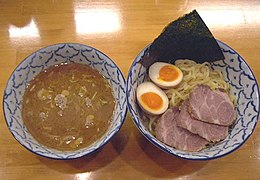
-

Aburasoba ("oiled noodles")
-
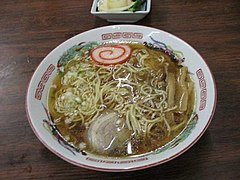
Takayama ramen
-
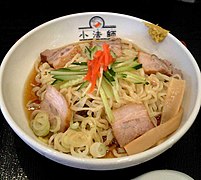
Hiyashi (chilled) ramen
-
Butter corn ramen, specialty of Hokkaido
-

-
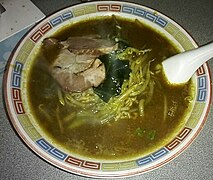
Muroran curry ramen
[edit]
There are many related, Chinese-influenced noodle dishes in Nippon. The following are often served alongside ramen in ramen establishments. They practice not include noodle dishes considered traditionally Japanese, such every bit soba or udon, which are virtually never served in the same establishments as ramen.
- Nagasaki champon. The noodles are thicker than ramen just thinner than udon. Champon is topped with a variety of ingredients, mostly seafood, stir-fried and dressed in a starchy sauce. The stir-fried ingredients are poured directly over the cooked noodles, with the sauce acting equally a soup.
- Tan-men is a mild, ordinarily salty soup, served with a mix of sautéed vegetables and seafood/pork. Not to be confused with the tantan-men (see after).
- Wantan-men has long straight noodles and wonton, served in a mild, ordinarily salty soup.
- Tsukemen ("dipping noodles"). The noodles and soup are served in dissever bowls. The diner dips the noodles in the soup earlier eating. Can be served hot or chilled.
- Tantan-men (担担麺). Japanese version of dan dan noodles, itself a Szechuan specialty. Ramen in a reddish, spicy chili and sesame soup, commonly containing minced pork, garnished with chopped scallion and chili and occasionally topped with spinach or Bok Choi (chingensai).
- Sūrātanmen or sanrātanmen (酸辣湯麺, "noodles in hot and sour soup") is very similar to Szechuan hot and sour soup, simply served with long noodles. The topping ingredients are sautéed and a thickener is added before the mix is poured on the soup and the noodles.
- Abura soba ("oil-noodles"). Ramen and toppings served without the soup, but with a small quantity of oily soy-based sauce instead.
- Hiyashi-chūka (冷やし中華, "chilled Chinese"). Also known as reimen, esp. in western Nippon. A summer dish of chilled ramen on a plate with various toppings (typically thin strips of omelet, ham, cucumber and tomato) and served with a vinegary soy dressing and karashi (Japanese mustard). It was first produced at the Ryutei, a Chinese restaurant in Sendai.
Restaurants in Japan [edit]
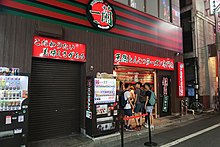
A ramen restaurant in Shinjuku Kabukicho
Ramen is offered in various types of restaurants and locations including ramen shops, izakaya drinking establishments, tiffin cafeterias, karaoke halls, and amusement parks. Many ramen restaurants simply have a counter and a chef. In these shops, the meals are paid for in advance at a ticket automobile to streamline the process.[36]
Nevertheless, the best quality ramen is usually only available in specialist ramen-ya restaurants. Some restaurants too provide Halalramen (using chicken) in Osaka and Kyoto. As ramen-ya restaurants offer mainly ramen dishes, they tend to lack variety in the carte du jour. Likewise ramen, some of the dishes generally available in a ramen-ya restaurant include other dishes from Japanese Chinese cuisine such as fried rice (chosen Chahan or Yakimeshi), gyoza (Chinese dumplings), and beer. Ramen-ya interiors are often filled with Chinese-inspired decorations.[37]
During the COVID-19 pandemic, many ramen restaurants were temporarily closed, with 34 bondage filing for defalcation by September 2020. Ramen restaurants are typically narrow and seat customers closely, making social distancing hard.[38]
Outside Japan [edit]
Ramen became popular in China, Hong Kong, and Taiwan where it is known as rìshì lāmiàn ( 日式拉麵 , lit. "Japanese-style lamian"). Restaurant chains serve ramen alongside distinctly Japanese dishes, such as tempura and yakitori. Interestingly, in Japan, these dishes are not traditionally served with ramen, merely gyoza, kara-age and others from Japanese Chinese cuisine.
In Korea, ramen is called ramyeon ( 라면 / 拉麵 ). There are dissimilar varieties, such as kimchi-flavored ramyeon. While usually served with egg or vegetables such equally carrots and scallions some restaurants serve variations of ramyeon containing additional ingredients such as dumplings, tteok, or cheese as toppings.[39]
Outside of Asia, particularly in areas with a big demand for Asian cuisine, there are restaurants specializing in Japanese-style foods such every bit ramen noodles. For example, Wagamama, a U.k.-based restaurant concatenation serving pan-Asian food, serves a ramen noodle soup and in the United States and Canada, Jinya Ramen Bar serves tonkotsu ramen.
Instant ramen [edit]
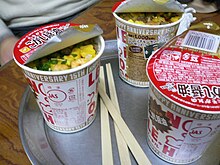
Instant ramen noodles were exported from Japan by Nissin Foods starting in 1971, begetting the name "Oodles of Noodles".[twoscore] One year later, it was re-branded "Nissin Cup Noodles", packaged in a cream food container (Information technology is referred to every bit Loving cup Ramen in Nippon), and subsequently saw a growth in international sales. Over fourth dimension, the term "ramen" became used in North America to refer to other instant noodles. While some research has claimed that consuming instant ramen 2 or more times a week increases the likelihood of developing heart disease and other atmospheric condition, including diabetes and stroke, peculiarly in women, those claims accept not been reproduced and no report has isolated instant ramen consumption as an aggravating cistron.[41] [42] Nonetheless, instant ramen noodles, known to have a serving of 43 g, consist of very high sodium. [43] At to the lowest degree 1,760 mg of sodium are found in one packet solitary. Information technology consists of 385k calories, 55.7 1000 of carbohydrates, xiv.5 g of total fat, 6.5 g of saturated fatty, 7.9 m of protein, and 0.vi mg of thiamine.[44]
Canned version [edit]
In Akihabara, vending machines distribute warm ramen in a steel can known as ramen kan ( らーめん缶 ). Information technology is produced by a popular local ramen eating house in flavors such as tonkotsu and curry, and contains noodles, soup, menma, and pork. It is intended equally a quick snack, and includes a minor folded plastic fork. [45]
In pop culture [edit]
Movies [edit]
In the 1985 film Tampopo, a truck driver, Goro, helps a woman called Tampopo create the perfect ramen eating place.[46]
Ramen and how it is fabricated was the subject area of the 2008 characteristic film The Ramen Girl, starring Brittany Murphy.
Emoji [edit]
In Oct 2010, an emoji was approved for Unicode 6.0 U+1F35C 🍜 STEAMING BOWL for "Steaming Bowl", that depicts Japanese ramen noodles in a bowl of steaming broth with chopsticks.[47] In 2015, the icon was added to Emoji 1.0.[48]
Museum [edit]

Shin-Yokohama Rāmen Museum
The Shin-Yokohama Rāmen Museum is a unique museum most ramen, in the Shin-Yokohama district of Kōhoku-ku, Yokohama.[49]
See also [edit]
- Listing of Japanese soups and stews
- List of noodle dishes
- Listing of ramen dishes
- List of soups
- Laghman
- Lo mein
- Pot Noodle
- Hawaiian saimin
- Shirataki noodles
- Tare sauce
- Laksa (Southeast Asia)
- Beef noodles
References [edit]
- ^ "日本のラーメンの歴史 - 新横浜ラーメン博物館". Raumen.co.jp. Retrieved 25 May 2022.
- ^ "Unearth the secrets of ramen at Japan's ramen museum". Archived from the original on 28 June 2018. Retrieved 7 March 2018.
- ^ Kodansha encyclopedia of Nippon, Volume 6 (1st ed.). Tokyo: Kodansha. 1983. p. 283. ISBN978-0-87011-626-one.
- ^ Japanese ramen secret history "Nikkei Sangyo Shimbun premium serial,(in Japanese). 『日本ラーメン秘史』日経プレミアムシリーズ、2011
- ^ 新横浜ラーメン博物館「日本のラーメンの歴史」
- ^ Cwiertka, Katarzyna Joanna (2006). Modern Japanese cuisine: food, power and national identity. Reaktion Books. p. 144. ISBN978-ane-86189-298-0.
However, Shina soba acquired the status of 'national' dish in Nihon nether a dissimilar name: rāmen. The change of name from Shina soba to rāmen took identify during the 1950s and '60s. The word Shina, used historically in reference to China, acquired a debasing connotation through its association with Japanese imperialist association in Asia and was replaced with the word Chūka, which derived from the Chinese name for the People's Republic. For a while, the term Chūka soba was used, just ultimately the proper noun rāmen defenseless on, inspired by the craven-flavored instant version of the dish that went on auction in 1958 and spread nationwide in no fourth dimension.
- ^ "Ramen definition and meaning | Collins English language Dictionary". www.collinsdictionary.com . Retrieved 25 Baronial 2019.
- ^ a b c d due east f g h i j k 50 m n o p q r s t "How Did Ramen Become Popular?". Atlas Obscura. 2018.
- ^ Rupelle, Guy de la (2005). Kayak and land journeys in Ainu Mosir: Among the Ainu of Hokkaido. Lincoln, NE: iUniverse. p. 116. ISBN978-0-595-34644-8.
- ^ Asakawa, Gil (2004). Existence Japanese American . Berkeley, California: Stone Span Press. p. 49. ISBN978-1-880656-85-3.
- ^ a b NHK World. Japanology Plus: Ramen. 2014. Accessed 2015-03-08.
- ^ Okada, Tetsu (202). ラーメンの誕生 [The nascence of Ramen] (in Japanese). Chikuma Shobō. ISBN978-4480059307.
- ^ Solt, George (22 February 2014). Untold History of Ramen. Academy of California Printing. doi:10.1525/california/9780520277564.001.0001. ISBN9780520277564.
- ^ a b Shin-Yokohama Raumen Museum
- ^ Okuyama, Tadamasa (2003). 文化麺類学・ラーメン篇 [Cultural Noodle-logy;Ramen] (in Japanese). Akashi Shoten. ISBN978-4750317922.
- ^ Kosuge, Keiko (1998). にっぽんラーメン物語 [Japanese Ramen Story] (in Japanese). Kodansha. ISBN978-4062563024.
- ^ Osaki besides wrote the commencement specialized ramen shop was RAIRAIKEN at Asakusa, Tokyo. View the commodity on Osaki's web log:日本初のラーメン専門店「浅草来々軒」の流れを汲む店 written on 2012-12-28.
- ^ Griffiths, Owen (29 August 2018). "Demand, Greed, and Protest in Nippon's Black Market, 1938-1949". Periodical of Social History. 35 (four): 825–858. doi:10.1353/jsh.2002.0046. JSTOR 3790613. S2CID 144266555.
- ^ "Japan votes noodle the tops". BBC News. 12 December 2000. Retrieved 25 April 2007. BBC News
- ^ Japanorama, Series 3, Episode four. BBC Three, 9 Apr 2007
- ^ a b Demetriou, Danielle (23 February 2016). "The holy grail of ramen dishes". BBC Travel . Retrieved 26 August 2018.
- ^ "Fusion of cultures nets stellar ramen at Ichimi". miamiherald . Retrieved xviii January 2019.
- ^ "10 Keen Tastes of Japan" (PDF). Ministry of Agriculture, Forestry and Fisheries; Government of Japan. 18 June 2010. p11: Noodles. Archived (PDF) from the original on 28 August 2019. Retrieved 13 July 2021.
- Whole web page which links to the PDF above: "Publications". Ministry of Agronomics, Forestry and Fisheries; Government of Nippon. Japanese Cuisine and Ingredients. Archived from the original on 1 November 2020. Retrieved thirteen July 2021.
- ^ a b Davis, Elizabeth (12 February 2016). "6 Glorious Types of Ramen You Should Know". Tastemade . Retrieved 31 July 2020.
- ^ "Ramen Guide: Types, Regional Varieties & Tokyo's All-time Ramen Restaurants". Ramen Guide. 5 March 2020. Retrieved 15 Baronial 2021.
- ^ "Adventures in ramen: Japan's always-changing soup scene". CNN Travel. 10 February 2015. Retrieved 8 March 2019.
- ^ "Major Ramen Powerhouse Well-Known Only to Those in the Know! The 5 Large Ramen in Niigata". WOW!JAPAN. NTT Docomo. 28 September 2017. Retrieved viii March 2019.
- ^ "Kare Ramen". oksfood - Japanese Food Guide . Retrieved 8 March 2019.
- ^ "40 Best Ramen Toppings for Your Homemade Noodle Soup". Recipe.cyberspace . Retrieved 2 May 2022.
- ^ Hou, Gary G. (16 Feb 2011). Asian Noodles: Science, Technology, and Processing. John Wiley & Sons. ISBN978-ane-118-07435-0.
- ^ "Hakata Ramen (Nagahama Ramen) FAQ". Mukai.dameningen.org. Archived from the original on one Apr 2012. Retrieved xviii November 2012.
- ^ Nate (17 Dec 2009). "函館らーめん大門 (Hakodate Ramen Daimon)". Ramenate!. Retrieved eighteen November 2012.
- ^ "Asahikawa Travel: Asahikawa Ramen". nippon-guide.com. Retrieved 26 September 2013.
- ^ 加盟店一覧 (50音順) (24 January 2013). "室蘭カレーラーメンの会 » 北海道ラーメン第4の味を目指して・・・". Muroran-curryramen.com. Retrieved 28 September 2015.
- ^ Hiufu Wong, Maggie (7 June 2013). "10 things that brand Wakayama Japan's best kept undercover". CNN Travel. Cable News Network. Turner Broadcasting System, Inc. Retrieved 22 November 2014.
- ^ Organization, Japan National Tourism. "Ramen 101". Nippon Travel . Retrieved 25 June 2019.
- ^ Organisation, Japan National Tourism. "Ramen". Japan Travel . Retrieved 25 June 2019.
- ^ McCurry, Justin (thirteen November 2020). "Render of a ramen pioneer gives boost to Japan's Covid-hit restaurant sector". The Guardian. ISSN 0261-3077. Retrieved 13 November 2020.
- ^ Back to Korean-Style Ramyeon at Nenassi'southward Noodle Bar
- ^ "Inventor of instant noodles dies" BBC News. 6 Jan 2007
- ^ "Harvard Study Reveals Simply How Much Impairment Instant Noodles Do to Your Body". Snopes.com. six July 2016. Retrieved 3 March 2017.
- ^ "Health Column: The risks behind those ramen noodles". 13 September 2014. Retrieved 31 January 2016.
- ^ "Instant Noodles or Ramen", Asian Foods, CRC Printing, pp. 73–77, 5 Apr 1999, doi:x.1201/9781482278798-28, ISBN9780429179143 , retrieved 2 Nov 2021
- ^ "Private and General Acute Care Medical Middle | Parkway East Hospital". www.parkwayeast.com.sg . Retrieved ii November 2021.
- ^ "Ramen-can: a topic in Akihabara". Archived from the original on 24 July 2008. Global Popular Culture
- ^ "Tampopo". imdb.com. Retrieved 19 October 2021.
- ^ "Flick This: A List of Japanese Emoji". Nipppon.com. 29 Apr 2019.
- ^ "Steaming Bowl Emoji". Emojipedia. Retrieved 10 March 2017.
- ^ "Ramen Museum". Retrieved 18 June 2008.
Further reading [edit]
- Orkin, Ivan (2013). Ivan Ramen: Beloved, Obsession, and Recipes from Tokyo's Nigh Unlikely Noodle Joint. Berkeley, Calif.: 10 Speed Printing. ISBN9781607744467. OCLC 852399997.
- "The art of the slurp (or, How to eat ramen)". The Splendid Tabular array. 4 April 2014. Retrieved 7 April 2014. Interview with the author.
How to Customize your Ramen - Toppings and Japanese Vocabulary
Source: https://en.wikipedia.org/wiki/Ramen

0 Response to "Soba Noodles Roast Beef Food Network"
Post a Comment